Time to read: 9 min
If you need to design plastic parts and quickly get them to market, then (surprise!) rapid injection molding might be your answer. Rapid injection molding is an excellent option for production-grade parts without waiting months for traditional hardened-steel tooling, especially if you require multiple mold iterations before you settle on a final design.
Rapid injection molding is considered “rapid” because the molds used can be produced more quickly and at a lower cost than traditional steel molds. Injection molding already has short cycle times, with the ability to produce parts in just a few seconds, but reducing the time to start producing parts can make the entire process even faster.
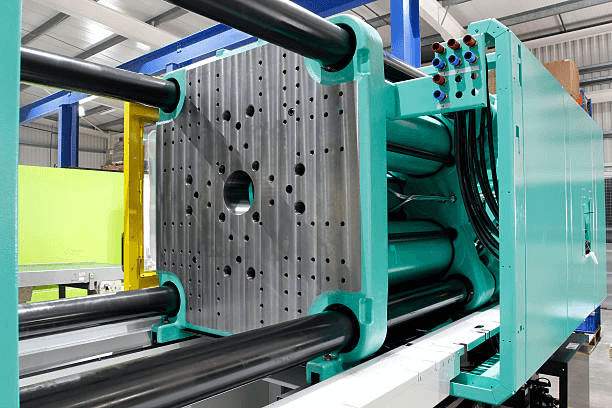
This comprehensive guide will cover rapid injection molding in detail. We’ll take a look at what exactly sets this process apart from “regular” injection molding, ideal rapid injection molding use cases, material options, and more.
What Is the Difference Between Rapid Injection Molding and Traditional Injection Molding?
The major difference between rapid and traditional injection molding is tooling, which affects speed and cost. Conventional injection molds can take eight weeks or longer to machine, whereas rapid injection molds—also called “prototype,” “soft,” or “quick” tools—are produced in a fraction of that time.
This makes design iterations much quicker than conventional molding, allowing manufacturers to achieve quicker customer sampling. This speed increase is possible because “rapid” molds are produced from softer materials that are easier to machine, such as aluminum or pre-hardened steels like P20. These tools still handle standard thermoplastics, so you get production-quality parts, just much faster.
However, there are some trade-offs to consider. Rapid injection molds typically may not achieve the same tight tolerances as molds made from hardened steel. Also, the production lifespan for rapid injection molds is shorter than that of conventional injection molds. Standard molds, being made from more durable materials, can handle more production cycles and wear and tear. They are therefore more suitable for high-volume production. Rapid injection molds, on the other hand, are better suited for prototyping or low- to medium-volume production.
Rapid Injection Molding vs. Traditional Injection Molding
| Feature | Rapid Molding | Traditional Molding |
| Mold Material | Aluminum, soft steels; made with CNC machine or a 3D printer | Hardened steel; using machining and heat treatment processes |
| Lead Time | Days to weeks | Weeks to months |
| Cost | Lower | Higher |
| Tool Life | Shorter | Longer |
| Cycles | As many as 100,000 – 500,000 (Fictiv) | Up to 1M+ cycles |
| Ideal Production Volume | Low- to mid-volume (100–10,000 parts) | Mid- to high-volume (10,000+ parts) |
| Design Flexibility | Greater (easier to modify and iterate designs) | More limited (design changes are costly and slow) |
| Accuracy and Tolerance | High accuracy but potentially looser tolerances | Very high accuracy and tight tolerances |
The Benefits of Rapid Injection Molding
Rapid injection molding comes with a few benefits, such as:
Fast Production
One of the biggest advantages of rapid injection molding is its speed. Tooling lead times are cut from months to weeks. This means you can go from a CAD design to real parts in as little as 7–10 days.
Lower Upfront Tooling Costs
Rapid injection molding uses less costly materials than normal injection molding, cutting initial tooling costs severely. This is ideal if you are doing a limited-edition product run or aren’t ready yet for full-scale production. You still create the products without having to commit to the costly permanent molds.
Easy Design Iteration
Rapid molds are quicker to adjust or replace. So, if you find issues in testing, you can fix your design and get a new mold quickly.
Bridge to Production
Rapid injection molding is a great stepping stone between prototype and full production. You can validate your design and build market-ready parts while waiting for final steel tooling.
Low-Volume Production Capabilities
Unlike traditional injection molding, which is optimized for high-volume production, rapid injection molding is perfect for producing smaller quantities of parts.

Design engineers need to balance rapid injection molding’s speed against other requirements.
When Should You Use Rapid Injection Molding?
There are three areas where rapid injection molding shines: rapid prototyping, low-volume production, and bridge tooling.
Rapid injection molding is an excellent option if you are on a tight timeline, especially during the early stages of product development. It’s ideal for functional prototypes made from production-grade materials, allowing for real-world testing without committing to long tooling timelines or the high expense of hardened steel molds.
Rapid mold development of a few weeks or less attracts companies that want to quickly validate part performance, get user feedback, or meet tight launch deadlines. While rapid injection molds typically have a shorter lifespan, they’re more than sufficient for low- to mid-volume production runs, pilot programs, or early market releases.
Another common use case is bridge tooling before full-scale production, especially when demand is uncertain or when your final steel molds are still in development. In addition, it’s a great choice for small batch production runs, limited-edition product releases, or pilot programs where a full investment in hardened steel tooling isn’t justified. If time to market is a top priority, rapid molding provides the speed and flexibility to meet aggressive deadlines without compromising part performance.
Rapid injection molding can create the same functional plastic products as regular injection molding, including containers, connectors, brackets, custom products, and industrial equipment. Injection molding and rapid injection molding are popular in industries such as medical, automotive, consumer electronics, aerospace, construction, and agriculture.
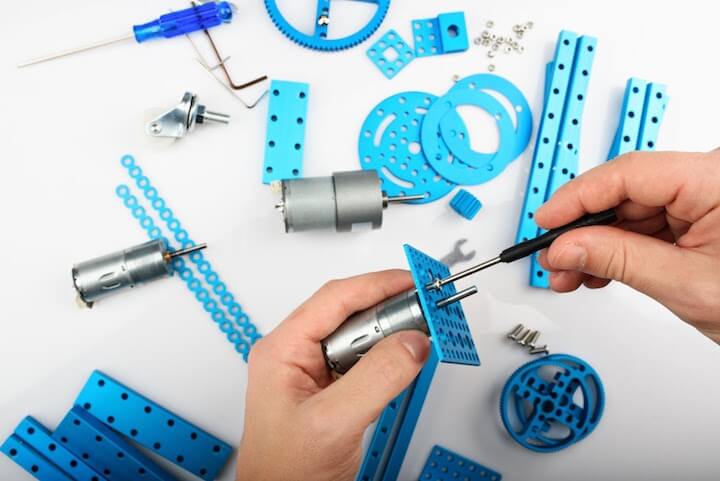
Rapid injection molded parts need tolerances that support alignment and assembly.
Technologies Used to Manufacture Rapid Injection Molds
There are currently three main technologies used to manufacture rapid injection molds:
CNC-Machined Molds
This is currently the go-to technology for rapid injection molds. Molds can be made from a variety of materials, including plastics and metals. CNC-machined molds can handle more cycles than 3D-printed molds because they are more durable.
3D-Printed Molds
3D-printed molds are fairly new to the injection molding industry, compared to more established technologies like CNC machining; however, they bring their own set of advantages to the table. 3D-printed molds offer increased design flexibility, especially for internal geometries where CNC machining is very limited.
3D-printed molds are also very quick and easy to design and print, and allow for speedy design iterations, which can be a major pro for companies still refining their designs. On the downside, 3D-printed molds do not have the same longevity as molds made from pure metal; however, they are excellent for custom designs with complex inner geometries.
Electrical Discharge Machining (EDM)
EDM is a specialized method used to shape hard materials or to create extremely fine details in mold cavities. It erodes material using controlled electrical discharges between an electrode and the mold block. EDM is especially useful for deep, narrow slots, sharp internal corners, or intricate surface textures that are difficult (or impossible) to achieve with traditional cutting tools. It’s often used alongside CNC machining to finish complex molds or add final precision features.
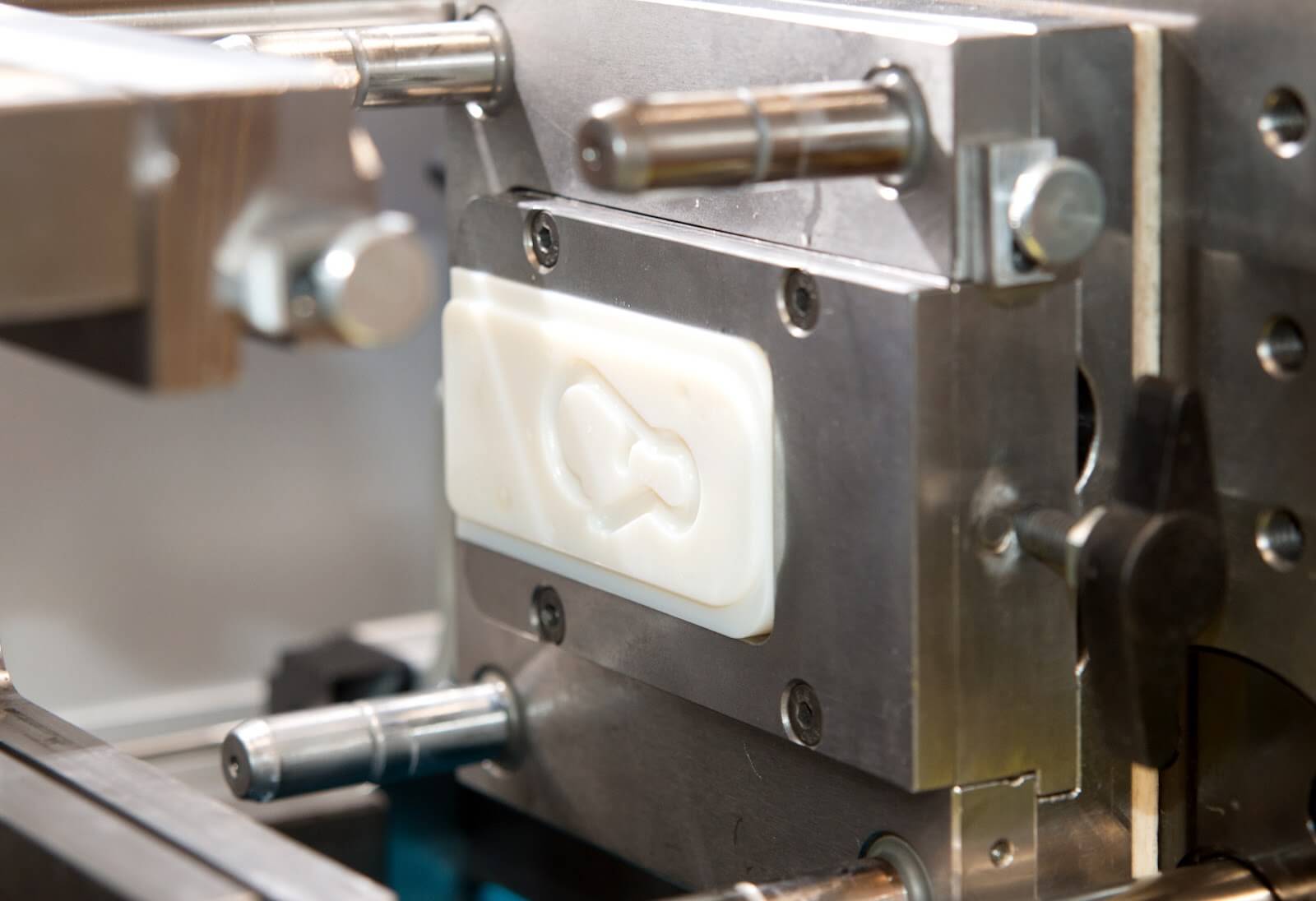
How to Design Rapid Injection Molds for Success
There are a few design best practices to keep in mind when designing rapid injection molds:
Keep Walls Uniform
Significant wall thickness variation causes cooling issues, which leads to warping or sink marks. A uniform wall thickness of between 1.5 and 2.5 mm is recommended to help prevent defects and allow for uniform cooling.
Add Draft Angles
Draft makes it easier to remove the part from the mold without damaging it or creating defects such as scratch marks and deformation.
Avoid Undercuts
Undercuts can complicate tooling and increase costs (although manufacturers can handle them with proper design for manufacturing).
Use Ribs and Bosses
Great for adding structural integrity and support without increasing wall thickness or part weight. Ribs help reinforce flat surfaces and bosses provide anchor points for fasteners, improving strength with minimal material use.
Material Selection
It’s important to select a material that is compatible with the mold material but will also perform as desired. Consider factors like strength, environmental conditions, thermal resistance, flexibility, and others.
By following these basic rules, you’ll reduce the chances of defects and get better parts faster.
Fictiv’s Injection Molding Design Guide examines each of these considerations in detail. While these factors apply to both traditional and rapid injection molding, the rapid process introduces unique challenges—particularly in material selection and part tolerances.
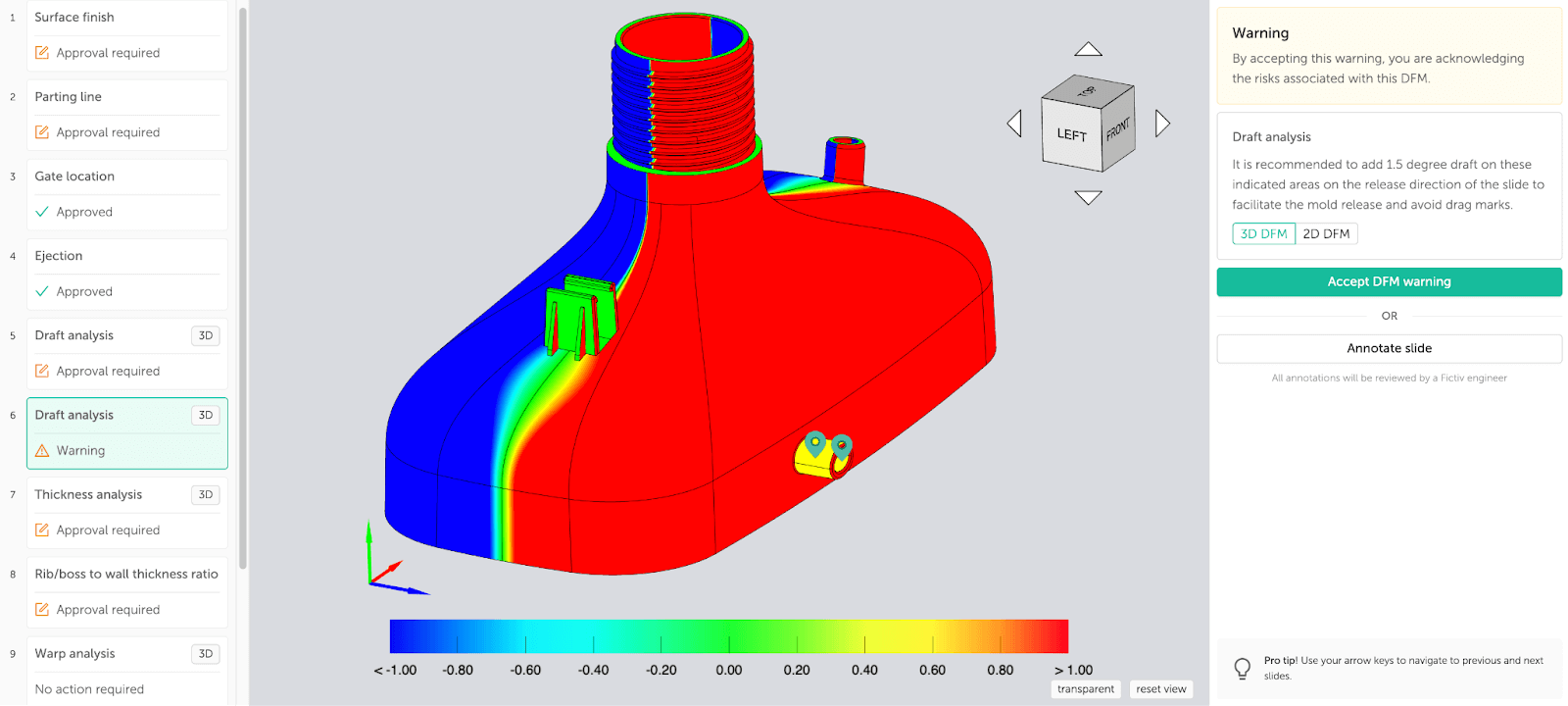
Fictiv provides DFM feedback along with your quote so that you get your parts made faster.
Compatible Material Options for Rapid Injection Molding
One of the biggest advantages of rapid injection molding is that you’re not limited when it comes to materials. Injection molding materials range from commonly used polymers to polymer blends. A wide variety of plastic resins are available, and they each have different end-use properties and processing requirements. Plus, the same plastic material can come in different grades, including resin types with glass or carbon fibers.
Most standard thermoplastics used in high-volume production work just as well with rapid tooling. That means you can prototype or launch early products using the exact same materials you’d use for full-scale manufacturing.
Popular materials for rapid injection molding include:
- ABS: A go-to for prototypes thanks to its strength, toughness, and versatility.
- Polycarbonate (PC): Great for impact resistance and optical clarity.
- Nylon (PA): Known for toughness and chemical resistance, but its abrasiveness can reduce mold life.
- Polypropylene (PP): Lightweight and flexible with excellent chemical resistance.
- TPE/TPU: For rubber-like flexibility and softness—commonly used for grips, seals, and wearable parts.
More specialized materials like glass-filled nylons, acetal (POM), or PEEK are also compatible, but they can wear down softer aluminum molds faster. PVC is another corrosive grade of plastic that can cause the injection mold to wear more rapidly.
Tool life usually isn’t a problem if you need prototypes or lower production volumes, but it’s worth considering how many parts you need. If you’re using these tougher resins, it’s worth discussing your volume expectations up front, so the mold can be designed accordingly.
Rapid molding also supports overmolding and insert molding for more advanced prototyping needs, though not every provider offers these as a standard service.
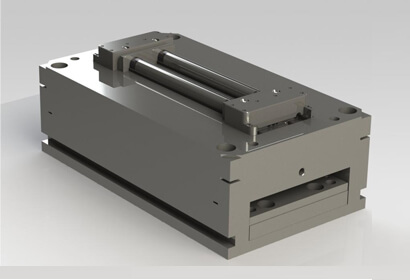
Tooling Materials for Rapid Injection Molding
Rapid injection molding utilizes a variety of tooling materials to provide quick and cost-effective production for prototypes and low- to medium-volume runs. The choice of tooling material is essential to balancing production speed, part quality, and budget.
Here’s a breakdown of the most commonly used materials for tooling:
Aluminum Molds
Aluminum is one of the most widely used materials for rapid injection molds due to its fast machining times and excellent heat transfer properties. Aluminum can be machined up to twice as fast as steel, and it doesn’t require post-machining heat treatment, which significantly shortens tooling times. Additionally, aluminum supports faster cycle times because of its superior heat dissipation.
However, aluminum molds have their limitations. They tend to wear out more quickly and are not ideal for parts requiring high clamping pressures or for plastics that require high processing temperatures, like PEI or PEEK. While aluminum molds can handle up to 10,000 shots, they’re better suited for lower-volume runs. The material also doesn’t polish as well as steel, so glossy or optically clear parts may not achieve the desired finish.
Soft and Semi-Hardened Steel Molds
Soft and semi-hardened steels, such as P20 and NAK80, are often preferred for parts requiring tighter tolerances or higher durability. Softer steels like P20 can be welded to support engineering change orders (ECOs), which are common during prototyping or early production stages. P20 tooling has lead times of about two weeks or less, making it faster than hardened steel but more durable than aluminum.
Semi-hardened steels like NAK80 are especially suited for producing glossy or optically clear parts as they offer a high level of finish quality. While they have a longer lead time than aluminum, they strike a useful balance between speed, cost, and performance.
Hardened Steel Mold Inserts
Though hardened steel is typically reserved for high-volume production, it can be used in rapid tooling applications in the form of inserts. These inserts are used in molds to enhance durability and support tight tolerances. They can be found in molds classified as SPI Class 104, which combine hardened steel inserts with bases made of less expensive materials like cast metal. While hardened steel inserts offer longer tool life and higher precision, they come with a higher cost and longer lead time compared to aluminum and soft steels.
Mantle3D metal inserts use paste deposition technology to add layers of metal paste that can then be machined and hardened in a high-temperature furnace. This creates 3D-printed inserts that surpass the performance and durability of traditional 3D printing. Mantle 3D printing is one emerging technology that Fictiv is actively leveraging.
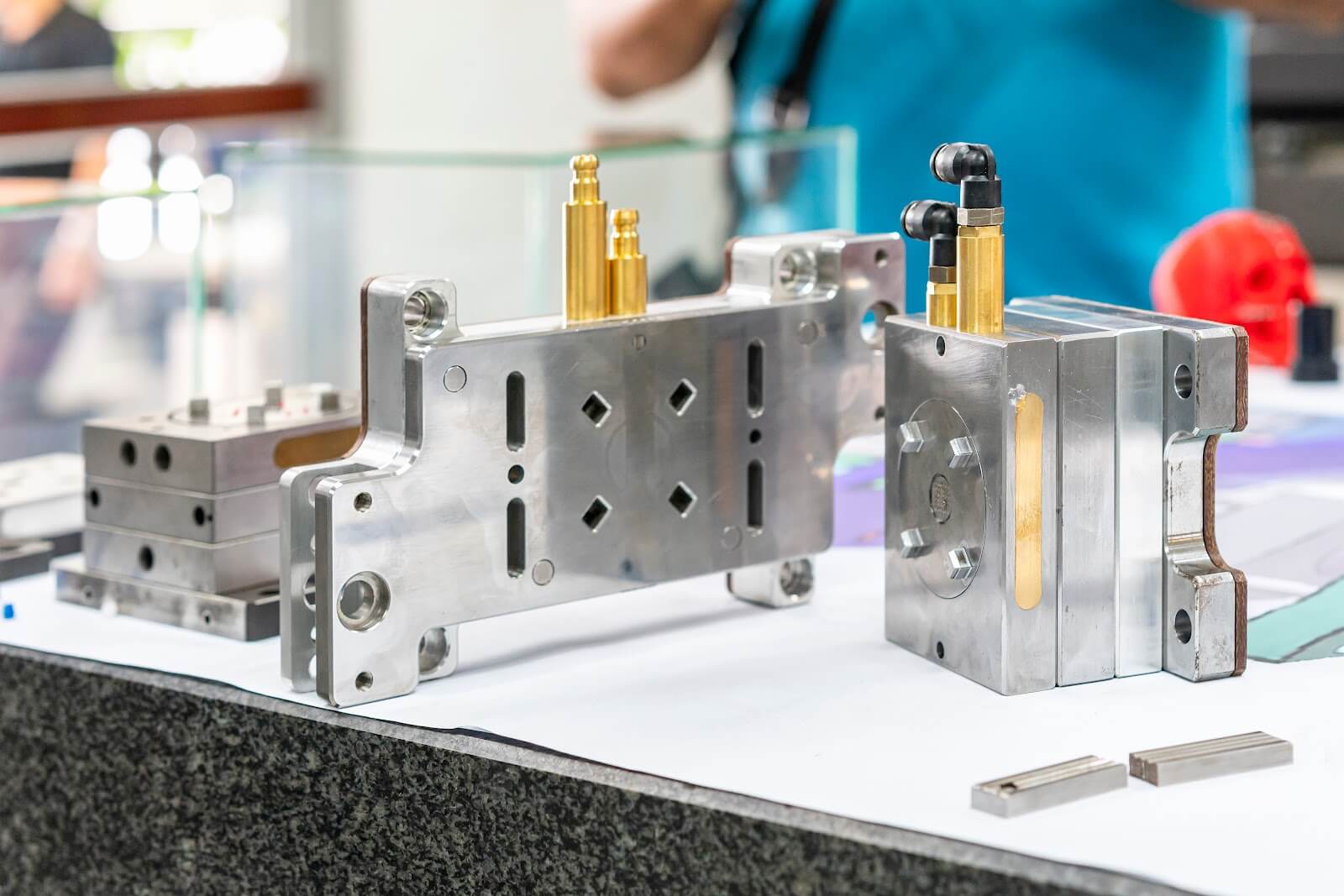
Getting Started With Rapid Injection Molding
Rapid injection molding involves many variables, so working with experts can help ensure smart, informed decisions for your project.
With Fictiv, getting started is easy. Simply create a free account, upload your part drawing, and receive a quote along with detailed Design for Manufacturability (DFM) feedback. Our in-house injection molding experts will support you throughout the process, from prototyping to production, offering recommendations that help you leverage the speed of rapid injection molding while meeting your specific requirements. Let us help you bring your ideas to life—fast.
Create your account to get started.










